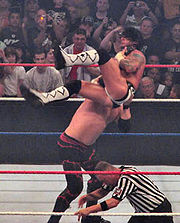
Chokeslam
Encyclopedia
A chokeslam refers to a type of body slam in professional wrestling
in which the wrestler grasps their opponent's neck, lifts them up, and slams them to the mat. It is common in televised wrestling because it is simple and relatively safe, yet looks powerful on camera. The chokeslam is typically used as a finisher by large wrestlers, further enhancing its perception as a powerful maneuver. This maneuver can be more damaging if the victim is slammed into an object, such as a table, steel chair, or garbage can.
The most common variety of chokeslam is performed with a single-handed choke. The wrestler places their free hand behind the opponent's back to help turn them horizontally for the throw. Although a chokeslam begins with a "choke", it is not usually considered to be an illegal move. The single arm choke that normally precedes a chokeslam is known as a goozle.
 In this elevated chokeslam the wrestler stands behind the opponent, puts his head under one of the opponent's arms, and lifts them onto his shoulder. The wrestler then pushes the opponent upwards, turns 180°, and grabs hold of the falling opponent's throat, driving them down to the mat back first.
In this elevated chokeslam the wrestler stands behind the opponent, puts his head under one of the opponent's arms, and lifts them onto his shoulder. The wrestler then pushes the opponent upwards, turns 180°, and grabs hold of the falling opponent's throat, driving them down to the mat back first.
The traditional version is also referred to as a double spinebuster/double front slam as the action of lifting an opponent up and throwing them down are much the same, though the spinebuster and front slam are more common on a charging opponent.
position and lifts them up in an inverted powerbomb. The wrestler moves his arm from around the opponent's neck, grabbing hold of their throat. The wrestler then slams the opponent down to the mat back first.
Professional wrestling
Professional wrestling is a mode of spectacle, combining athletics and theatrical performance.Roland Barthes, "The World of Wrestling", Mythologies, 1957 It takes the form of events, held by touring companies, which mimic a title match combat sport...
in which the wrestler grasps their opponent's neck, lifts them up, and slams them to the mat. It is common in televised wrestling because it is simple and relatively safe, yet looks powerful on camera. The chokeslam is typically used as a finisher by large wrestlers, further enhancing its perception as a powerful maneuver. This maneuver can be more damaging if the victim is slammed into an object, such as a table, steel chair, or garbage can.
The most common variety of chokeslam is performed with a single-handed choke. The wrestler places their free hand behind the opponent's back to help turn them horizontally for the throw. Although a chokeslam begins with a "choke", it is not usually considered to be an illegal move. The single arm choke that normally precedes a chokeslam is known as a goozle.
Back suplex chokeslam

Chokeslam backbreaker
The wrestler performing the move stands in front of and slightly to the left of the opponent receiving it. The wrestler then reaches out and grabs the opponent's throat and trunks, and lifts him or her in the air as though the wrestler is about to deliver a chokeslam. However, as the wrestler brings the opponent back down to the mat the wrestler kneels, slamming the other wrestler's back onto his or her extended knee. This move is popularly known as a chokebreaker/choke breaker, which is a portmanteau of this move's technical name.Double chokeslam
When two wrestlers execute a chokeslam on a single opponent at the same time it is referred to as a double chokeslam. Due to convenience of wording, a double chokeslam can also refer to two chokeslams being performed by a single wrestler on two opponents at the same time (i.e. single person double chokeslam), and occasionally in a tag team match where each member of one team will chokeslam a member of the opposing team (i.e. simultaneous / stereo chokeslams) which can also be referred to as stereo chokeslams.The traditional version is also referred to as a double spinebuster/double front slam as the action of lifting an opponent up and throwing them down are much the same, though the spinebuster and front slam are more common on a charging opponent.
Inverted powerslam chokeslam
Like the vertical suplex chokeslam, but in this variant, the attacking wrestler puts the opponent in a powerbombPowerbomb
A powerbomb is a professional wrestling throw in which an opponent is lifted up and then slammed back-first down to the mat. The standard powerbomb sees an opponent first placed in a standing headscissors position...
position and lifts them up in an inverted powerbomb. The wrestler moves his arm from around the opponent's neck, grabbing hold of their throat. The wrestler then slams the opponent down to the mat back first.

